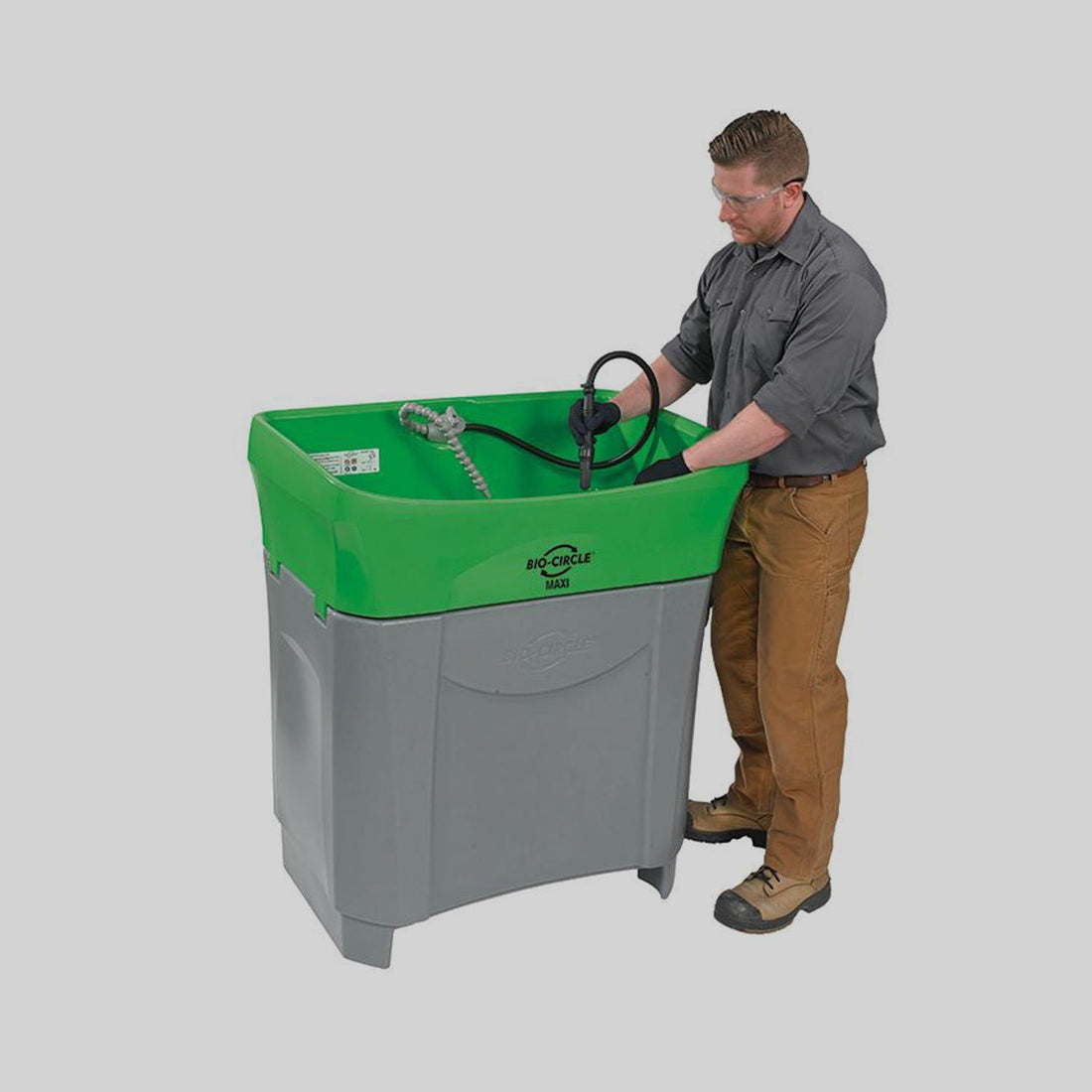Although solvent-based parts washer systems have been around for the last 70 years, much has improved. 18 years ago Phase III pioneered the "water-based microbial" parts washer system, today every competitor has their own version. What separates Phase III's system from the rest of the competition is experience and quality. Many companies promote the benefits of the bacteria, without knowing what or how it really works. Many companies sell their "cleaner" as some sort of "black magic". The like making-up stories to answer questions, instead of providing facts through education and experience.
First, you need to decide if you want a "solvent-based" or "water-based" system. To help you make the right decision, you need to ask yourself what you are looking for. Cost can be the motivating factor in deciding on a system. Stamped steel units are initially affordable and can be purchased from $150-$450.
Solvent-based parts washer
You can find 30-gallon drums of parts washer solvent at some auto parts houses and tool supply shops. Expect to pay around $200 per drum, which usually lasts about 3 months. So there you go, $650 for a turn-key, ready to use unit! Three months later and your working in your shop when you realize that your solvent just isn't working as well as it use to. The reason is that you have "loaded-up" the solvent or "killed-it" as many say at this point.
This is where things get sketchy for many shop owners... how to get rid of it? First, you must locate a company that will pick it up and dispose of it for you. That cost is about $300 and you will be responsible for that material until it is ultimately disposed of. There are companies out there, that will sell/lease you a parts washer, provide you with solvent and change it out for you. This type of services will cost you about $250 every few months, depending on your usage.
Service programs are usually contracted and can be difficult to get out of without a penalty. One thing to also consider if you choose a solvent-based system. If you bump into the parts washer and knock it over, it is now a hazardous spill, so please keep that in mind when you positioning the unit. A "report-able" 30-gallon hazmat response will run you about $5,000 to start. This will not including recovery absorbents, disposal, temporary business shut-down, etc.
Solvent Safety
Solvent units are that they are pretty cheap to get into initially, but there are some things that need to seriously be considered. One issue is with the disposal and liability of the used solvent. Safety with solvents should also be taken into consideration. Solvents are hydrocarbon-based and can be very toxic and your employees should always follow all of the safety requirements provided by the solvent supplier. Always remember to wear your safety glasses and gauntlet style, solvent resistant gloves at the bare minimum.
These last safety recommendations are good to follow with any parts washer solutions. Another "CON" could be your liability for the used solvent. Many times "you" will be personally liable for any issues arising out of environmental impact, should an accident occur. Be sure to specifically ask your provider about this clause in the contract. Many solvent-based parts washer contracts will tie you up 1-3 years and cost you between $900-$1,500 per year.
Water- based parts washer
Now on to what I consider the good stuff, water-based, microbial, parts washer solutions. The reason that I like it, is purely from the safety and environment aspect. I have met people that have used solvent systems for years, the physical toll that it takes on your body is not good. I don't care how safe people say solvents are, when your hand is in them every day, it will eventually take a toll on your body, both hands and internal organs. Many companies have made an effort to manufacture less harmful solvent, but that is like making a less lethal bullet. What I am getting at, is that no matter how safe someone says their solvent is, it still is unsafe to many degrees.
First of all, they function differently than solvents. Solvents work from the inside out through "solvent action" and water-based cleaners work from the "outside in". Think of it this way, like chemicals remove like chemicals. The best way to remove red wine from a fabric is to use white wine. The wines share a like chemistry and allow the two wines to dissolve and loosen one another. This is why solvents work best at removing grease and grime and why other people say that water-based cleaners don't work. Modern chemical engineering is pretty amazing and some great new formulations have come to market.
Oil Sponge HD Cleaner with microbial bio-tab
We like to think that Phase III has the best water-based cleaner on the market, called Oil Sponge HD. The report that I am speaking about was conducted by the National Aerospace and Space Administration, yes N.A.S.A. and backed-up by the Rochester Institute of Technology. In an effort to replace solvents in parts washers, the US government found it necessary to source the leading water-based technologies available on the market. There were many criteria to defining this report including; efficacy, safety, environmental impact, use, cost and most importantly, "realized cost". When all of the calculations were completed, Oil Sponge HD ranked as the #1 cleaner! Consider for the moment that a water-based cleaner beat solvents for cleaning efficiency.
Using the microbial bio-tablet in your parts washer solution, helps to extend the life of your cleaner. Phase III pioneered this technology in 1996 in a request from the Marine Corps base at Camp Pendleton in California. The "active cultures" in the tablet help in degrading the organic oils, grease and grime that is found in the used cleaning solution. By naturally and organically degrading the oils and grease in the cleaner to carbon-dioxide and water, the cleaner maintains its cleaning efficacy much longer. Extending the life of your cleaner reduces your operational costs, saving you money.
Perceived Cost versus Realized Cost
The last item is the most important issue for many people, is what it actually costs to use or operate your parts washer. If I told you that a cleaner cost $100 per gallon and another cost $20 per gallon, which would be cheaper? You can't answer that until you do some research first. That $100 cleaner may have a great benefit like it cleans just as well at the "ready-to-use" $20 cleaner does and at a 1:100 dilution ratio. This means that the $100 cleaner has a "realized cost" of $.99 per gallon vs. $20 per gallon. It is important to remember that the selling price is not what determines the value.
The Bio-Circle Parts Washer
The number one thing to look for in a parts washer system is quality. A parts washer is a big investment and you would be better-off to spend a little more for quality, then a little less for savings.
This is a primary reason why Phase III now distributes the Bio-Circle Maxi parts washer. The Maxi parts washer is built using the highest quality plastic construction that can be found in the industry today. It has a very large wash basin and an excellent filtration system and is easy to operate and service. Keeping your cleaning solution is the #1 priority with any parts washer system. A key feature to the Bio-Clean washer, are the four steps the fluid passes through before the cleaner returns to the sump.
- A 50 micron string filter initially cleans the fluid before it enters the either the brush or articulated arm.
- In the basin, the primary screen stops the largest debris.
- A second screen below, stops the larger soil from entering the sump.
- A magnet helps stop any metal pieces that have made it through the first two filters.
- The last stage is an "optional" and reusable filter bag, that does a final filtration of the cleaner before it returns to the sump.
When using the Oil Sponge HD cleaner in the Bio-Clean parts washer, evaporation can be a primary concern. To help prevent unwanted evaporation, the "Maxi" parts washer has a weighted, "flapper-valve" that closes when the unit is not in use.
A simple "one touch' control button turns on the pump, heater unit and aerator of the parts washer. The pump gives ample flow to either a brush or articulated fluid wand to deliver the cleaner to the parts. Heat is an important feature in aqueous cleaning and the heater unit keeps the fluid at a comfortable 103-105 degrees. The aerator provides needed oxygen to the cleaning solution and active cultures functioning.
Why should you choose the Bio-Circle Maxi parts washer?
The "Maxi" parts washer is a very straight forward design with simple controls and ease of maintenance features, not found in other parts washers. It has a robust construction which will last the owner for years. An easy-tilt top basin allows the user quick access to the sump for checking fluid levels and cleaning. An optional "hard surface" caster unit that makes the washer mobile, so you can take easily move it to where you are working. The "Maxi" parts washer is also very easy and inexpensive to service. No need to hire a third-party company to come out and service your machine, it can easily be done by you or your in-house personnel. Phase III offers all of the parts and cleaners necessary to service the unit.
All of the features of the Bio-Circle "Maxi" parts washer system make it an industry leader. When you use the Oil Sponge HD cleaner and microbial bio-tab, it simply "IS" the best parts washer system on the market today. Contact us at oilsponge.com with any questions that you might have.







